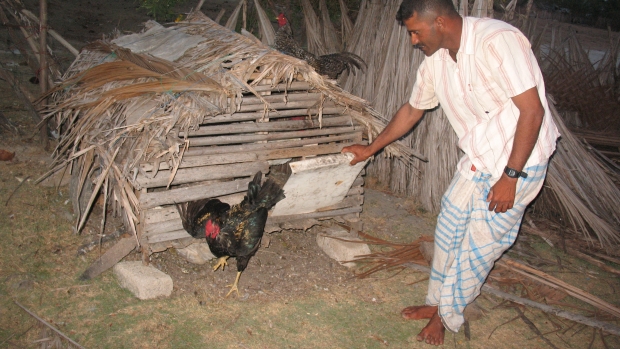Grants :: Small Grant Facilities :: Providing micro-finance loans for alternative livelihoods that reduce pressure on coastal ecosystems in Kalpitiya, Puttalam District
Providing micro-finance loans for alternative livelihoods that reduce pressure on coastal ecosystems in Kalpitiya, Puttalam District

Micro finance scheme recipient - back yard chicken rearing , Puttalam © Kumudini Ekarathttp://www.mangrovesforthefuture.org/#Root_Topicsne, 2012
Objectives
- Conserving coastal resources in the area
- Developing livelihoods and enhancing income generation
- Reducing malnutrition
- Empowering women
Background
Ammathottam – a fishing village – is located on the western coast of Puttalam Lagoon in the Kalpitiya DS Division in the Puttalam District. Here, communities depend on lagoon fisheries – particularly for seafood. The Puttalam Lagoon is being fished currently at a rate of one and a half times the amount it should be and according to these communities, the fish catch is decreasing. In addition, habitat destruction for infrastructure development and pollution from shrimp farms and cultivation are further damaging this vital Lagoon.
This community at Ammathottam is also poor and malnourishment among children is rising.
Poverty and a high dependence on a declining natural resource leave this community with few options to improve their quality of life. Providing alternative livelihoods to this community to improve their well-being while reducing the pressure on Lagoon resources is, therefore, important.
Interventions:
- A group of 50 women participated in an awareness programme on the importance of coastal ecosystems and resources discussions were held on the importance of protection of the environment of the Puttalam Lagoon; the importance and rehabilitation of mangroves; the damage to fish from harmful fishing methods; and the community’s responsibility to protect natural resources of the Lagoon.
- One hundred women were trained in several kinds of self-employment as listed below. Marketing facilities for their products have been identified.
- Initially, eight women were given loans to start their own income-generating activities totalling about 375 USD (50,000 LKR). In the second round, 12 women were given loans amounting to about 710 USD (95,000 LKR). Finally, 13 women received in total approximately 780 USD (105,000 LKR). When part of the funds was recovered by the grantee, an additional nine women received loans. Individual loans ranged between ~37 USD (5,000 LKR) and 74 USD (10,000 USD).
- The funds were distributed as follows: dry fish production (3); poultry farming (8); goat rearing (7); vegetable cultivation (8); weaving palm fronds (6); small shop (2).
- An awareness programme on the preparation of a nutritious meal was carried out for 45 women.
- A community pressure group comprising two men and 11 women, social activists, school principals and the Grama Niladhari (village headman) was formed.
Target beneficiaries
42 women from fisher families.
Outputs
- Awareness programme on coastal management
- Established Pressure Group
- Two training programmes on coastal management
- One training programme on self employment activities
- One training programme on nutritional food preparation
- Micro finance loan scheme for women
Accomplishments and challenges
More women are requesting loans and training for self-employment.
On average, a woman earns the following as supplemental income for her household:
|
Activity |
Amount of loan given |
Profit made (per month) |
|
Dry fish production |
~ 37 USD (5,000LKR) |
~30 USD (4,000LKR) |
|
Poultry farming |
~ 75 USD (10,000 LKR) |
~45USD (6,000 LKR) |
|
Goat rearing |
~ 75 USD (10,000 LKR) |
Not sold at the time of preparing this fact sheet |
|
Vegetable cultivation |
~150 USD (20,000LKR) |
~150 USD (20,000LKR) over 5 months (which comprises a growing season) |
|
Weaving palm fronds |
37. 6 USD (5,000 LKR) |
~22 USD (3,000 LKR) |
|
Small shop |
~ 75 USD (10,000 LKR) |
~66 USD (9,000 LKR) |
- This additional income is saved or used for children’s needs. It is particularly important as income from fisheries is dropping because of decreasing fish catch. This income ranges from 40-80% of a fisherman’s income. In the case of the shop, it exceeds the main family income.
- All beneficiaries have started paying back their loans. Those with smaller loans have paid back in full.
- The capital is used as a revolving fund, and repaid loans are used for new loans.
- In general, these communities had been lax about ensuring that their children ate balanced meals. After the awareness programme, mothers are making herbal porridge for their children. The Ayurvedic hospital in the area is willing to conduct further awareness programmes.
- The pressure group is vigilant about community members who damage mangroves, and report these infractions to the Grama Niladhari.
Contributions to cross-cutting themes
The direct beneficiaries were 42 women. But the entire family benefited from the additional income generated through the micro-finance scheme.
Lessons Learned
Any project dealing with micro-finance needs to be monitored closely and grants should be given on an instalment basis, depending not only on the success of the livelihood but also on whether repayments have been made.
Project Facts
Country
Location
Ammathottam in Kalpitiya, Puttalam District
Topic
Duration
1st May 2011 to 30th Apr 2012
MFF Grant Amount
LKR 500,000.00
Co-financing Partner
Direct beneficiaries are women. However they are assisted by male members of the families as and when needed.